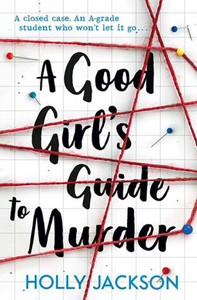For her high school capstone project, Pippa Fitz-Amobi decides to go over a closed murder investigation from five years in the past, believing the late Sal Singh is not the murderer of Andie Bell. Among her early interviewees is the local crime reporter who refers to Sal as a “murderer” in print before he’s convicted and who believes Indians don’t value life like white people do.
Uh oh, I thought, “A Good Girl’s Guide to Murder” (2019) is going to be a heavy handed lecture about prejudice. But – although I had some issues later in the novel – Holly Jackson ends up penning a page-turning debut, mostly because the clueing and plausibility are excellent.
A dogged young sleuth
Although it could function as a “My First Murder Mystery” for a teen, “Good Girl’s Guide” is strong enough by the end that I wouldn’t object to following Pip’s further adventures in the next two novels and one novella – or the TV adaptation coming later this year.

“A Good Girl’s Guide to Murder” (2019)
Author: Holly Jackson
Genre: YA mystery
Setting: Connecticut, 2019, investigating events from 2014
Note to readers: The Book Club Book Report series features books I’m reading for my book club, Brilliant Bookworms.
Jackson does a good job of showing that Pip is a hard worker (her parents even scold her for it) via her first-person capstone project notes. These chapters alternate with third-person portrayals of her investigating, often done with partner Ravi, the younger brother of the disgraced and deceased Sal. They both believe he was innocent, although there’s strong evidence against him.
In her capstone notes, Pip includes a “persons of interest” list at the end of each section. “Good Girl’s Guide” is a methodical, meat-and-potatoes presentation in this way. The suspicious characters tend to be types, rather than nuanced humans (although no others are as one-dimensional and unlikely as the bigoted journalist). The good characters tend to be pure as snow, and Jackson points out the non-white races of certain good people, whereas the bad people’s races are not emphasized.
But Pip is a very likable lead character. Her organizational skills make her a worthy guide, but she’s also a 17-year-old working on her first case, and Jackson allows room for experienced genre readers to spot things she overlooked. At one point, I did feel too smart for “Good Girls’ Guide,” as Pip overlooks a clue right in front of her face; at another point, she makes a rookie mistake by being too trusting of a suspect. But the mystery is complex enough that it didn’t turn the journey into something boring.
Searching for her identity
I like how Pip is fretting to define herself (for the sake of a college application, with the deadline looming). She doesn’t realize she’s in the midst of defining herself as a sleuth. But that’s how people are; they don’t see the obvious things about themselves.

Jackson is British, and the American version of the book is set in Connecticut, so “Good Girl’s Guide” lacks flavor of location it might have in the English version. Her editors – apparently deciding American teens wouldn’t be interested in learning about British teens (which seems fishy, but I’m not in marketing) — do a serviceable job of adjusting. They illustrate how rural New England features small towns short distances from each other, so people might regularly bounce between towns when running various errands.
This allows for the novel to be simultaneously about a bigoted backwater town and to have geographical space for secrets to be buried if someone drives a short distance. Plausibility can run away from a first-time author aiming for a complex mystery, and I’m impressed with how this doesn’t happen to Jackson. Every character’s actions – plus the reason why the police halted the investigation – make sense.
I must note one laughable part. In a branch off the main plot, we learn some teens were in a situation that comes directly from “I Know What You Did Last Summer.” Perhaps Jackson intended a tip of the cap to Lois Duncan’s 1973 novel, a landmark in YA mystery writing. But unfortunately this side plot reads as a lazy ripoff, especially since the “IKWYDLS” franchise is still in the spotlight, with a recent TV series and a planned fourth movie.
But Jackson’s prose is strong, and particularly eye-opening in a segment where she’s describing someone under the influence of drugs. The characters could use more nuance; maybe that happens in future books, and actors could help with that when the series jumps to the screen. “A Good Girl’s Guide to Murder” will launch as a BBC series in July. If it uses the novel as a strict plotting guide, it’s unlikely to go wrong.

